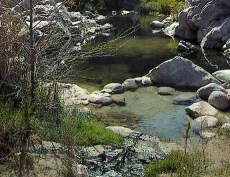Flower forecast aglow
Desert areas such as Joshua Tree and Anza-Borrego parks are soaking up wet weather in anticipation of spring blooms
01/09/2003
By BARBARA E. HERNANDEZ
THE PRESS-ENTERPRISE
Desert wildflowers may bloom more brightly this spring because of recent rains sprinkling across the desert.
"Four inches is average for Joshua Tree; so far, we've received 1.6 inches," said educational specialist Lorna Lange-Daggs at Joshua Tree National Park.
At the Anza-Borrego Desert State Park in San Diego County, park officials said they've received 1.55 inches of rain, more than last year's entire rainfall.
"We've been very short on water, but the rain we've gotten has been just the right kind -- gentle, soaking rain," said Joanie Cahill, park interpretive specialist for Anza-Borrego Desert State Park. "If we get some rainfall every couple weeks or in the next couple months, we can still have a nice flower bloom."
The rains have been a relief from the drought conditions of 2002.
"Last year was the most barren and probably one of the most bleak years we've had," Cahill said.
Desert blooms of yellow, orange and purple flowers can transform bleak desert landscapes into worlds of magical color.
But even without a desert bloom, there are many alternative attractions in desert parks. Anza-Borrego has several hiking trails that head from desert floor to mountainous pine forests.
At Joshua Tree National Park, visitors can commune with Joshua trees, learn about mining history and study amazing geological formations.
Chris Cantelmo, a biochemist from Hermosa Beach, was one of many recent visitors to the park who came for a lot more than wildflowers.
"We're here to introduce our friends to Joshua Tree," he said, adding that the group had gone on one ranger-led walk around Barker Dam.
Martha Callahan, who was camping with her two children and husband, drove from Flagstaff, Ariz.
"We're here to enjoy the day," she said, unpacking food. She and her family have gone to campfire talks, but didn't know if she would this time.
"With camping, everything is about seeing if you feel up to it," she said.
The desert can seem bleak and desolate to some, but many animals, including the bobcat and California kingsnake, make their home in the most inhospitable parts of the park. Numerous cacti, including the cholla cactus that can cause stinging pain if brushed against, palms and even grass populate the area. Frogs also inhabit the desert in the rainy season.
The desert can also be a dangerous place, and park officials stress that visitors should bring water with them and layer clothing.
RANGER PROGRAMS
Friday
2 p.m. -- Rock of Ages (1 hour, 1 mile); meet at Arch Rock trailhead, across from campsite 9 in the White Tank campground.
7 p.m. -- Evening program at Jumbo Rocks campgrounds.
Saturday
9 a.m. -- Lost Palms Oasis Hike (5 hours, 8 miles); meet at Cottonwood
Visitor Center.
10 a.m. -- Barker Dam Nature Walk (1.5 hours, 1 mile); meet in parking
area at Barker Dam.
2 p.m. -- Meet the Joshua Tree (1 hour, 1/2 mile); meet at Cap Rock
parking area at Keys View Road and Park Boulevard junction.
2 p.m. -- Oasis Walk (1 hour, 1/2 mile); meet on patio of Oasis Visitor
Center.
7 p.m. -- Evening program.
Sunday
10 a.m. -- 12 p.m. Views from Keys View (15-minute presentation) Keys
View overlook.
2 p.m. -- Made in the Desert (1 hour, .5 mile); meet at Split Rock picnic
area.
Wild Flowers afoot
All posts are those of the individual authors and the owner
of this site does not endorse them. Content should be considered opinion
and not fact until verified independently.
| Subject | Author | Views | Posted |
|---|---|---|---|
| katrina island | 3444 | January 10, 2003 02:51PM |
Sorry, only registered users may post in this forum.



